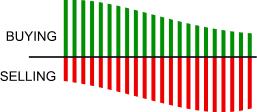NT,
“If 50 widgets were sold yesterday, isn't this exactly the same as saying that 50 widgets were bought yesterday?”.
I’ve been grappling with this question and thought as you do – for every buyer there is a seller. But I think it goes deeper than this (we may be venturing into the realms of metaphysics).
Assume the price is currently 100. I’ll buy at 95, but you’ll only sell at 105. Am I buying to open (go long) in anticipation of a rising market, or buying to close (a short) to get out of a potentially deteriorating position?
Conversely, are you selling to open (go short), anticipating a falling market or selling to close (a long) to take profits or cut losses.
The price suddenly takes off and a sense of urgency/desperation enters into the equation. If I’m looking to open, I won’t chase the market, thus no trade. If closing, reluctantly I may have to accept your (high) offer. Hence, a trade.
Now your position. I doubt you would sell short on a rising price, so no trade here. If long, hold the position for further profit/reduced loss. Again, no trade.
Now assume the price takes a dive. I wouldn’t go long on a falling price – no trade. If short, I’ll hold – no trade.
You won’t chase the market to go short, so no trade. If you’re long, reluctantly you’ll have to accept my (low) bid, thus a trade.
So, is it possible to differentiate between willing and reluctant/forced buying/selling? (If I’ve confused bid and offer in this context, ignore it.)
Oh, no – not VBA. I bought a VBA book but suffer foreboding whenever I open it - the kind of book that once put down, you can’t pick up. The problem is trawling through almost 700 pages to understand the procedures and protocols for what are really simple solutions to simple problems. Or maybe the problems are actually complex and beyond my comprehension, namely how do I raw access raw data from my price feed – where is it? Thank you for link – I’ll certainly look at it.
I’m OK with Excel.
Grant.


